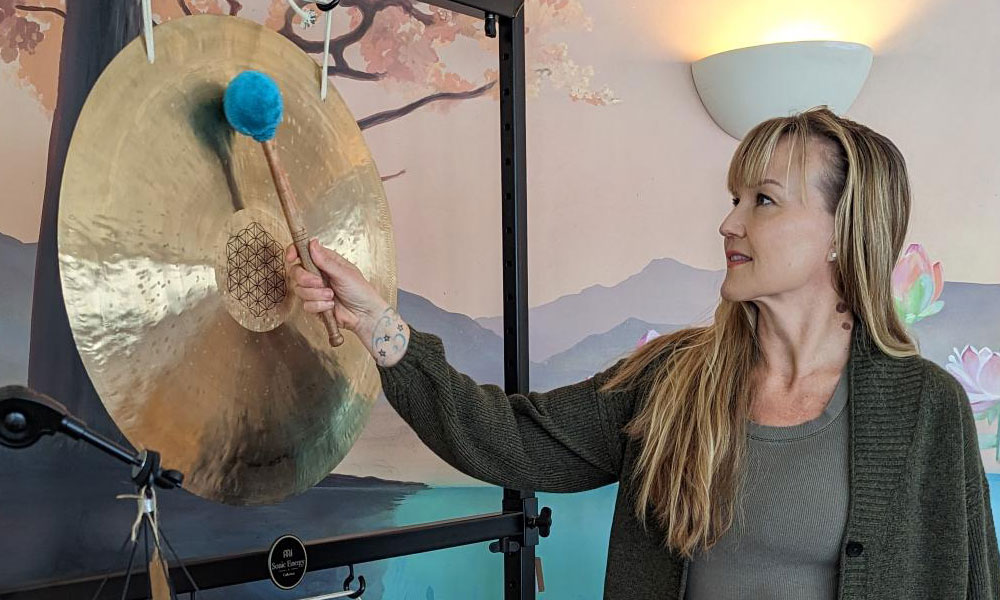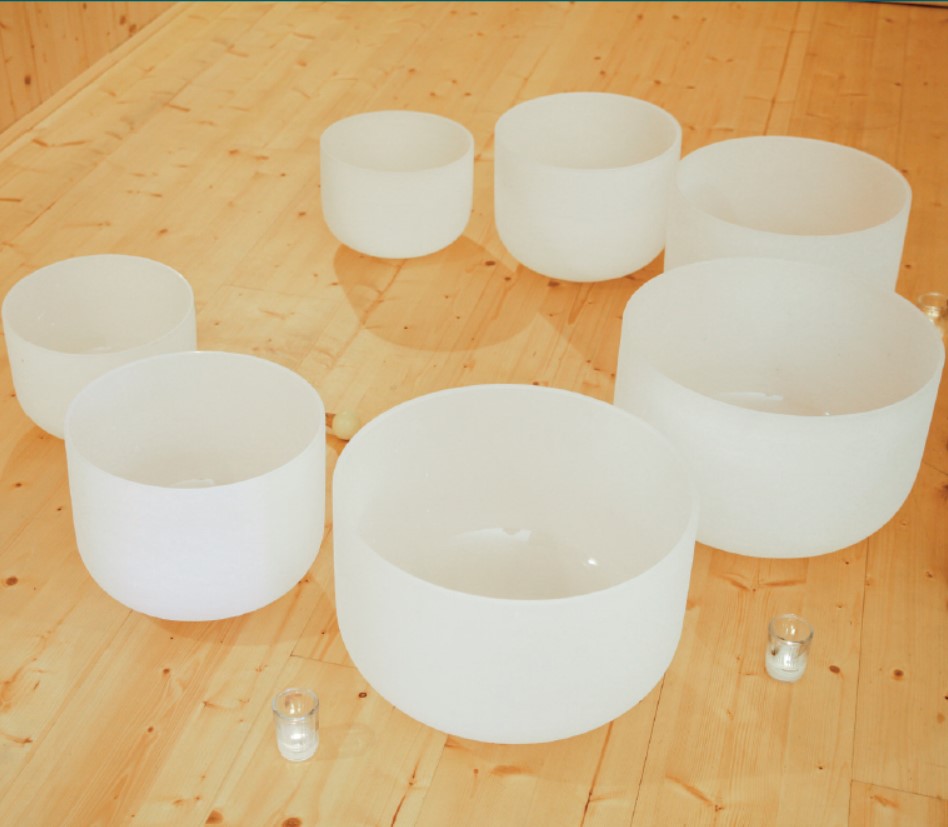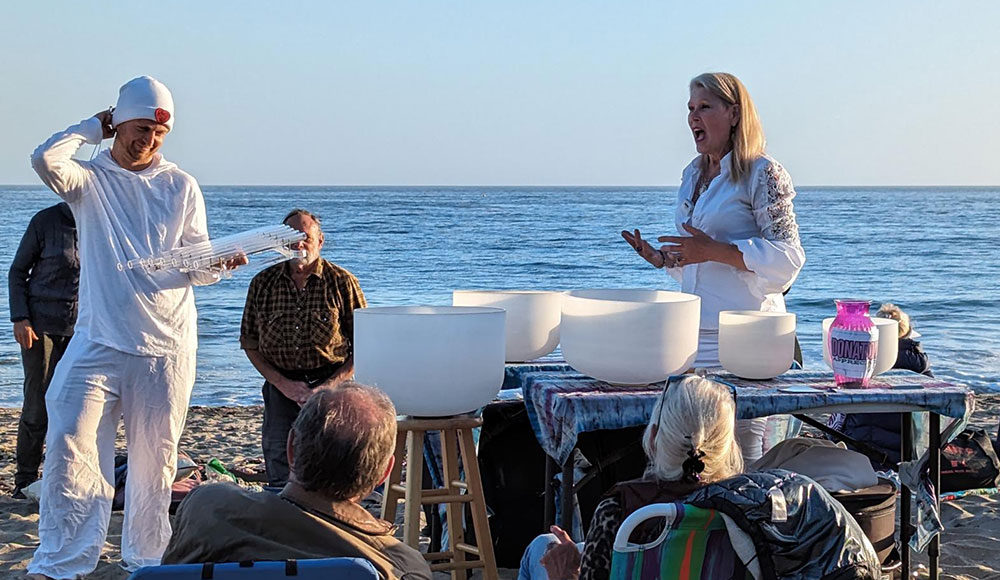I am sitting at my home office desk, researching the local sound bathing scene, when a sudden blast of searing clatter makes my head swim. I reach for the ear plugs kept close for such occasions, knowing the neighbor’s gardeners will finish their auditory assault on errant leaves in 30 minutes or so.
In a world where the level of noise continues to rise, leaving our already overloaded senses in a terminal state of imbalance, a sound bath sounds like a very good remedy.
Sound has a timeless connection to meditation and healing, deeply rooted in cultures around the world. Australian Aboriginal tribes have been using the didgeridoo for more than 40,000 years as a powerful tool for sound healing. Meanwhile, Tibetan and Himalayan spiritual ceremonies have long featured the soothing tones of singing bowls. Today, sound meditation, particularly in the form of “sound baths,” is gaining popularity.
These immersive experiences use instruments like Tibetan singing bowls, quartz or crystal bowls, gongs and bells to guide listeners. They emphasize that sound is more than something you hear—it’s something you feel, resonating through tactile vibrations and frequencies.
Sound bathing has been described as stepping into a sanctuary of tranquility where time seems to slow, in a mystical experience that transports you to realms of deep relaxation, as waves of harmonic vibration wash over your body and allow access to the subconscious mind.
This may sound abstract and even exaggerated. Yet one recent study published in the Journal of Evidence-Based Integrative Medicine found that an hour-long sound meditation helped people reduce tension, anger, fatigue, anxiety and depression while increasing a sense of spiritual well-being
And then, the terms sound bathing and sound healing are often used interchangeably, sometimes followed by claims extending beyond relaxation into larger promises of healing pain, disease and past life trauma. As I did research for this article, I went in with a curious mind. I was sold on the relaxation benefits, but wondered what one could expect from 45 minutes of surround sound beyond that.
My introduction to sound bathing came long before I planned to write about it. I was new to Santa Cruz County and loved the idea of combining sound and meditation in a relaxed group setting.
The session featured a combination of sound and reiki, a form of light-touch energy healing. Not sure what to expect, I walked into the quiet, softly lit room where 20 or so comfortably dressed people were lying down in yoga class style on mats, equipped with plenty of blankets, bolsters and eye pillows.
I followed suit and found a place at the back of the room in case I needed to sneak out early. As the session began, a young man sporting a long beard and even longer white robe began working his way through the array of instruments arranged at the back of the room. There were the ubiquitous crystal bowls, as well as chimes and gongs of all shapes and sizes, and the aforementioned didgeridoo.
I closed my eyes and let myself relax, absorbing the soft, deep notes that began to fill the room. As the instruments gently changed, the sounds seemed to waft in from all corners of the room. Lying there adrift in surround sound, I had to break the spell and open my eyes to see how this worked. Indeed, Emerson was silently weaving his way through the space, bathing the participants in a symphony of sound.
Not typically one to find solace in lying still, I was surprised to find the resonant notes transporting me to a state of calm relaxation. Meanwhile the reiki practitioner lightly touched my temples, furthering the meditative state I found myself in.
The hour passed quickly and I left in a state of tranquility. I was eager to learn more about the mechanics of sound bathing. Is it healing, or a great way to unwind? I interviewed three local experts in this newly trending art.

SURROUNDED BY SOUND
Carrie Arlah Burr is a co-owner (along with her mom, Leslie Warren) of Capitola yoga studio Breath and Oneness, where I teach a weekly vinyasa class.
I meet Burr at her studio, where she immediately takes a seat on the floor of the carpeted sound room, inviting me to follow suit. After a somewhat awkward start, I regain my composure and ask about her journey into sound and music, which she says is deeply intertwined with yoga.
“It’s difficult to discuss one without the other as they are so closely related for me,” she explains. “My experience with sound and music started early in my life. I was raised in a household where music was a constant presence. Both of my parents were classically trained musicians, and I started learning instruments at a very young age.
“My first instrument was the piano, and over the years, I expanded my repertoire to include a variety of other instruments and took up singing. I was part of a professional choir for most of my youth, and I received extensive training in music theory.”
She describes how her technical and formal training in music continued through college. She even released an album in her early 20s (Arklah, on Spotify). Then, after a decade of intense involvement in music, she took a break for about 10 years.
At Breath and Oneness she began integrating sound into practices, offering sound baths and incorporating live music into yoga sessions.
“While not everyone who practices or teaches sound healing comes from a musical background, for me, it was foundational,” says Burr. “My technical training in music deeply informs the sound healing work I do, as well as the training programs we offer.”
Recognizing that sound healing is deeply embedded in human history, Burr believes there is a resurgence of interest in using sound as an efficient way to bring bodies into a state of coherence and alignment.
“When we first introduced sound healing at our studio, we started with crystal tone bowls, which I believe are particularly powerful for this time. Crystal bowls are relatively new instruments, having been around for only a few decades, but their specific frequencies and vibrations seem to resonate well with the current needs of people,” she says. “They are among the most effective tools for consciousness work that I have encountered.”
But, I ask, who attends—and why?
“People come to our sound healing sessions for various reasons, but common experiences include relaxation, spiritual connection and meditation. The sound healing sessions act as portals, amplifying whatever intentions people bring with them. Whether it’s relaxation, meditation or seeking spiritual messages, sound healing enhances these experiences through its coherent and intentional vibrations. The benefits of sound healing are multi-faceted, encompassing physiological, spiritual and emotional aspects.”
She elaborates, “The instruments we use in our sound healing sessions are carefully selected for their quality and the specific type of healing they offer. For instance, the gong is an indispensable instrument in this art form due to its powerful and transformative vibrations. Other instruments like hand pans, tongue drums, and Tibetan singing bowls also play a crucial role. These instruments are sourced from reliable and trusted suppliers to ensure they are of high quality and produce the desired healing effects.”

PEERING INTO THE CRYSTAL BOWL
Fast forward to a Tuesday evening in June, where the scene unfolding on Moran Lake Beach in Santa Cruz resembles a Hollywood movie set. A silver-haired dude in a Hawaiian shirt is setting up to film a sound bathing session. His subject is a blond woman wearing a flowing white tunic, surrounded by large crystal bowls and dozens of seated spectators. I’m here after a Good Times colleague described sound bather Kim Molloy’s weekly sunset sessions as life changing. And the strong following of attendees growing steadily over the past 10 years would seem to agree.
Intrigued, I meet Molloy at the Farm restaurant in Aptos. In response to my questions, she describes her work as a transformative modality that harnesses the power of sound frequencies to promote physical, emotional and spiritual well-being. She says every sound practitioner brings a unique approach to this practice, shaped by their personal journey and development in sound healing.
Molloy’s introduction to sound healing began in 2012 with crystal bowls during a meditation session led by her teacher on the East Coast. The experience immersed her so deeply that when it ended, her teacher had to call her back to reality. This initial session ignited her curiosity and set her on a path to explore the potential of sound healing.
“I discovered that the energy body, which can be equated to the spirit, has the capacity to travel into higher dimensions and vibrations through sound,” she explains. “This revelation became a cornerstone of my spiritual practice. When I moved to California, I sought to continue my practice but found that the local crystal bowl practitioner had moved. My meditation teacher suggested that perhaps it was my turn to take on this role.”
She reached out to a clairvoyant and intuitive named Amira, who selected a set of crystal bowls based on her energy. Each bowl corresponds to a musical note that resonates with a specific chakra, aligning the body’s energy centers through sound.
Molloy says the magic of sound lies in its ability to bypass the mind and work directly on the body, clearing energy blocks, increasing energetic flow and promoting relaxation. Many people enter a theta brainwave state, associated with deep relaxation and meditation, during sound healing sessions. This state allows for a heightened sense of peace, creativity and spiritual awareness.
Group sessions, including her donation-based community event “Sunset Beach Bowls,” offer a collective healing experience. Held every Tuesday at Moran Lake Beach, these sessions attract 100-150 people. The event features a blend of crystal bowls, the sound of ocean waves and a bonfire, creating a healing environment that incorporates all four elements: earth, water, air and fire.
People bring chairs, blankets and sometimes even picnics. Despite the casual atmosphere, the core group of attendees is deeply engaged in the healing process, positioning themselves between the bowls and the ocean to fully immerse in the sound.
Molloy says sound healing works as a catalyst for personal transformation. It helps individuals move forward on their healing journey, whether they are dealing with trauma or seeking spiritual growth. The process can be likened to peeling an onion, gradually uncovering and releasing layers of deep-seated emotions stored in the cellular memory.
Kim Johnson, a client of Molloy’s since 2021, describes individual sessions where she relaxes lying down on an amethyst crystal pad, with one healing bowl near the crown of her head and others surrounding her in a cocoon of sound.
SOUND AND THERAPY
Shira Stone may be the original Santa Cruz sound bather.
“It’s a beautiful thing, but what I do goes even deeper into healing,” she says. “It’s not quite sound bathing, though I do sound baths. What I do is a deep dive into frequencies, emotions and trauma.”
She began with a thriving massage practice. Her 15 years in the business gave her a true hands-on approach to understanding how the body is connected to emotions. From there, she says, sound healing came into her life through a past life memory, unexpectedly.
“About 40 years ago, sound healing wasn’t really a thing. I was doing a massage on a friend, and he asked me to do something different. I opened up, trusting that unexpected things could happen. Suddenly, Tibetan bowl sounds started coming out of my mouth. I had never heard these sounds before.”
Stone saw herself “in an ancient amphitheater with everyone making the same sounds. There was a person in the center, and we were directing the sounds to them. I did the same with my friend’s throat, and it was like a revelation: This is your path.”
Stone began experimenting with sound healing, working both individually and in groups, discovering the profound impact it could have. It was consistently transformative.
This journey led her to psychotherapy, and she earned her license in 1988, leading to further training in somatic therapy, including a four-year bioenergetic program, all of which helped refine her approach.
In sessions, Stone guides people to give voice to the sensations in their bodies, particularly those linked to trauma, encouraging them to focus on bodily sensations and express these feelings vocally.
“If someone feels tightness in their chest, I guide them to vocalize this sensation,” she says. “Naming the emotion helps the brain relax, facilitating healing. This process is about reconnecting with buried emotions. Trauma often buries emotions in the body, disconnecting them from consciousness. By giving voice to these emotions, individuals can reconnect them with the rest of their being, restoring harmony.”
Group sessions are also a significant part of this practice. The collective voice in a group setting can amplify the healing effect. In these sessions, people sound together to heal one person in the center or participate in group sound baths and community healing sessions using their voices collectively.
When asked for an example, she explains how she helped a woman with unexplained stomach pains to vocalize the fear sensed in her belly, which she discovered was linked to unacknowledged childhood trauma. Releasing that fear brought relief.
Stone says people seek out her services when dealing with issues like low self-esteem, anxiety, depression or relationship troubles, often without realizing these problems are linked to trauma. Sound healing guides them to connect with their bodies and uncover hidden emotions. Sessions vary in format; sometimes they involve sitting and talking, focusing on bodily sensations, while other times she uses a massage table and sounding over specific areas of the body. Sessions always end with harmonious sounds to foster a sense of love and calm.
Stone’s approach goes beyond typical therapy by deeply integrating sound and somatic practices. It’s all about reunification and helping people reconnect with their authentic selves. By listening to and expressing their emotions, individuals find healing and harmony within themselves.
In a world that seems to be getting noisier by the minute, sound healing offers a sanctuary. Even if it only offers a subtle form of healing in the way massage or breathwork or yoga do, that’s enough for me. Beyond relaxation, it’s a gateway to testament to the timeless power of sound in human healing. Each session, whether enhanced by the vibrations of crystal bowls or the supportive energy of a group, offers a sanctuary for those seeking relaxation, spiritual growth or a means to navigate life’s emotional complexities.














Well written but I don’t see the names of Justin and his girlfriend who play the harps and are also a big reason people going there every Tuesday.